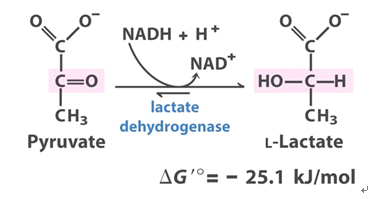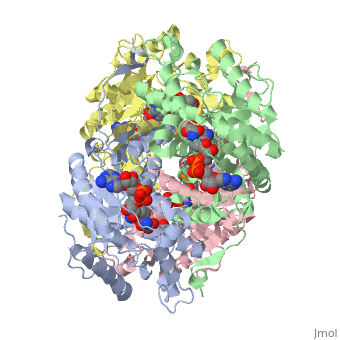User:Kelly Roark/Sandbox1
From Proteopedia
Contents |
Lactate Dehydrogenase
Lactate dehydrogenase (LDH) is an enzyme that catalyzes the stereospecific interconversion of lactate and pyruvate [1]. This reaction is known as anaerobic homolactic fermentation and is an important way to regenerate NAD+ to allow glycolysis to continue [2]. Nicotinamide adenine dinucleotide (NAD+ or NADH) is the cofactor for the reaction aand acts as a hydrogen acceptor or donor [3].
Characteristics of LDH
LDH functions as a tetramer in vivo and is made of two kinds of subunits, H and M, each of which are encoded by a different gene. This results in 5 different isoenzymes (2 homotetramers and 3 heterotetramers) [1]. Different isoenzymes have different catalytic and physical properties, are regulated differently, and expressed in different kinds of tissues [3]. These differences are due to the different kinetic properties of the different subunits [2]. The subunits associate randomly; thus, isoenzyme expression in different tissues is determined by the availability of each type of subunit, which in turn is decided by the relative synthesis rates of the subunits and the gene expression for each tissue type [1].
The M subunit is found predominantly in anaerobic tissues including skeletal muscle and liver [2]. The H subunit is more commonly found in tissues with a ready source of oxygen and that metabolize lactate including the heart and the brain. In heart muscle, the H4 homotetramer is most commonly found but the H3M isoenzyme is also found at a lower level of expression.
The H4 isoenzyme usually functions in the cytoplasm and is not membrane bound like the M subunit isoenzymes may be. Due to the high ratio of NAD+: NADH, the H subunit in heart muscle is usually complexed with NAD+ [3]. The H subunit form of LDH usually catalyzes the forward reaction: the oxidation of lactate to pyruvate shown above. This generates NADH which is then further utilized in the cytochrome system to generate more energy in the form of ATP [1]. The H subunit is regulated by a negative feedback inhibition loop and is inhibited by millimolar amounts of pyruvate [4]. When pyruvate levels reach a threshold level, it binds to and forms a complex with LDH, inactivating it. This decreases the number of available enzymes to catalyze the reaction and stalls the conversion of lactate to pyruvate and also keeps the NAD+:NADH ratio at an optimum level [1].
Purification Strategies
LDH is purified from both animal and plant tissues based on its biochemical properties. The net surface charge for the H4 isoenzyme is -6 while the net charge of the M form is +1 [2]. The overall negative charge of the H subunit allows the H4 isoenzyme to be purified initially using anion exchange chromatgraphy [5]. It is also possible to use its affinity for an NAD+ analog or it substrates to purify LDH using affinity chromatography. The individual subunits have a molecular weight of around 35,000 kDa [5]. The activity of the enzyme can be assayed by monitoring changes in ratio of NAD+ to NADH at 340nm on a spectrophotometer where an increase in nm means NAD+ is changing to NADH and vice versa [1].
Structure of LDH
|
|
As stated above, LDH is a tetramer and each monomer is folded into two domains that are catalytically independent with little interaction between them [6]. The consists of a Rossman fold: an open, twisted, six stranded, parallel beta sheet flanked by three alpha helices on each side [2]. The cofactor binds in a groove at one end of the beta sheet. Once the substrate has bound, the cofactor is further positioned by between residue 30 and the adenosine phosphate and residue 247 and the nicotinamide phosphate [4]. The elements in each of these resdiues are color coded as follows: C, O, N.
The is adjacent to the nicotinamide group of the cofactor. The binding pocket consists of an overall alpha/beta structure which is highly and consists of residues 163-247 and 267-331 [2].
The substrate is bound deep into the LDH:NADH binary complex (10 Å) at the interface between the two domains [2]. The is located in the binding pocket and contains the catalytically crucial His 193 as well as Asp 168, Arg 171, Thr 246 and Arg 106, all of which contribute to the catalytic geometry of the active site [2]. Another important structure is the (residues 95-105) which includes the catalytically important Arg 106 [3]. The mobile loop extends into solution in the apoenzyme (when the cofactor is not bound) and is closed across the substrate binding site when the cofactor and substrate are bound. It is open to accept substrate for binding and then closes to sequester the binding pocket from the solvent and to introduce Arg 106 into the active site [7]. Arg 106 hydrogen bonds to the carbonyl of the substrate [2].
Binding Interactions
LDH binds to its NAD+ cofactor to form the binary complex. The adenosine of NAD+ binds in the crevice and is oriented by a hydrogen bond between N1 and the hydroxyl group of a specific residue [4]. The residues are colored according to the follwoing key: Hydrophobic,Polar. The binary complex is in a range of conformations, some of which are able to bind the substrate (open conformation) and some of which cannot (closed conformation). These forms are in equilibrium; however, the equilibrium lies with the closed conformation [8].
Eventually an open binary complex encounters a molecule of substrate. Approximately 15% of the enzyme unfolds around the binding pocket so that it the substrate can reach the active site [3]. The substrate is brought into the binding pocket through a salt bridge that forms between the negatively charged carboxyl group of the substrate and [3]. When the substrate is positioned close to the active site, the mobile loop closes over the active site entrance bringing (a key catalytic residue) deep into the active site pocket and in close contact with the substrate [7]. Closure of the loop prevents solvent access to the active site and facilitates hydride transfer. Loop closure also causes the enzyme to tighten around the substrate and NAD+ cofactor, bringing them into the proper geometry for catalysis. Loop closure is facilitated by interactions between Arg 106 on the loop and both phosphates of the cofactor [4]. Collapse of the loop also helps orient the pro-R hydrogen on the C4 carbon of the nicotinamide ring into close alignment with the proper side of the substrate for hydride transfer [8].
The loop collapse also increases the number of charged and hydrophilic groups which balance the charge on NAD+ (achieved by ) and on His 193 (achieved by Asp166) after the hydride transfer [4].
is provided by Ala 236, Thr 246, Arg 171, Gln 102, and Arg 109. Gln 102 and Arg 109 are both located on the underside of the mobile loop and come into contact with the substrate only after loop closure [2]. The positioning of the substrate in respect to C4 of the nicotinamide ring, H193 and R171 determines the specificity of the enzyme for L-lactate as opposed to D-lactate [4]. The loop remains closed over the active site until catalysis is complete and then opens to release the product [9].
Catalytic Mechanims
Lactate to pyruvate:
A hydride ion is transferred directly from the C2 carbon of lactate to C4 carbon of the nicotinamide ring and a proton is transferred from the lactate hydroxyl group to N3 of H193 [8]. This results in formation of pyruvate and NADH; it also gives H193 a positive formal charge which is by Asp166 in the binding pocket [4].
Pyruvate to lactate:
A hydride ion is directly transferred from the pro-R face of NADH to the C2 carbon of pyruvate and a hydrogen from the N3 group of H193 is transferred to the carbonyl oxygen [7]. His 193 acts as the catalytic acid and is stabilized by asp 168. This results in the formation of lactate and NAD+; the positive charge on NAD is stabilized by [4].
Allosteric Regulatory Site
In some bacteria, LDH is allosterically activated by fructose 1,6-biphosphate (FBP)[6]. LDH is non-allosteric in vertebrates.
In the tetramer , there are four active sites but only two FBP binding sites. The FBP binding site is at the horizontal plane of symmetry of the tetramer [6]. Arg 173 and His 188 form salt bridges with the phosphates of FBP to bind FBP in the binding pocket. The binding site is adjacent to the active site and His 193. FBP binding neutralizes the positive charge repulsion at the subunit interface and causes a conformational change in the interface and the quaternary structure. The active site is affected by the conformation change and takes on an active conformation. All four active sites are activated at the same time; the allosteric effect is concerted throughout the tetramer [6].
References
- ↑ 1.0 1.1 1.2 1.3 1.4 1.5 Markert CL. Lactate dehydrogenase. Biochemistry and function of lactate dehydrogenase. Cell Biochem Funct. 1984 Jul;2(3):131-4. PMID:6383647 doi:http://dx.doi.org/10.1002/cbf.290020302
- ↑ 2.0 2.1 2.2 2.3 2.4 2.5 2.6 2.7 2.8 2.9 Read JA, Winter VJ, Eszes CM, Sessions RB, Brady RL. Structural basis for altered activity of M- and H-isozyme forms of human lactate dehydrogenase. Proteins. 2001 May 1;43(2):175-85. PMID:11276087
- ↑ 3.0 3.1 3.2 3.3 3.4 3.5 McClendon S, Zhadin N, Callender R. The approach to the Michaelis complex in lactate dehydrogenase: the substrate binding pathway. Biophys J. 2005 Sep;89(3):2024-32. Epub 2005 Jun 24. PMID:15980172 doi:10.1529/biophysj.105.062604
- ↑ 4.0 4.1 4.2 4.3 4.4 4.5 4.6 4.7 Adams MJ, Buehner M, Chandrasekhar K, Ford GC, Hackert ML, Liljas A, Rossmann MG, Smiley IE, Allison WS, Everse J, Kaplan NO, Taylor SS. Structure-function relationships in lactate dehydrogenase. Proc Natl Acad Sci U S A. 1973 Jul;70(7):1968-72. PMID:4146647
- ↑ 5.0 5.1 Labrou NE, Clonis YD. Biomimetic dye affinity chromatography for the purification of bovine heart lactate dehydrogenase. J Chromatogr A. 1995 Dec 1;718(1):35-44. PMID:8556165
- ↑ 6.0 6.1 6.2 6.3 Fushinobu S, Kamata K, Iwata S, Sakai H, Ohta T, Matsuzawa H. Allosteric activation of L-lactate dehydrogenase analyzed by hybrid enzymes with effector-sensitive and -insensitive subunits. J Biol Chem. 1996 Oct 11;271(41):25611-6. PMID:8810336
- ↑ 7.0 7.1 7.2 Pineda JR, Callender R, Schwartz SD. Ligand binding and protein dynamics in lactate dehydrogenase. Biophys J. 2007 Sep 1;93(5):1474-83. Epub 2007 May 4. PMID:17483170 doi:10.1529/biophysj.107.106146
- ↑ 8.0 8.1 8.2 Zhadin N, Gulotta M, Callender R. Probing the role of dynamics in hydride transfer catalyzed by lactate dehydrogenase. Biophys J. 2008 Aug;95(4):1974-84. Epub 2008 May 16. PMID:18487309 doi:10.1529/biophysj.108.132464
- ↑ Shinoda T, Arai K, Shigematsu-Iida M, Ishikura Y, Tanaka S, Yamada T, Kimber MS, Pai EF, Fushinobu S, Taguchi H. Distinct conformation-mediated functions of an active site loop in the catalytic reactions of NAD-dependent D-lactate dehydrogenase and formate dehydrogenase. J Biol Chem. 2005 Apr 29;280(17):17068-75. Epub 2005 Feb 25. PMID:15734738 doi:10.1074/jbc.M500970200



